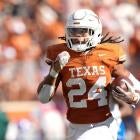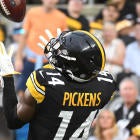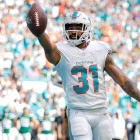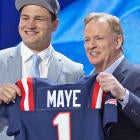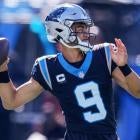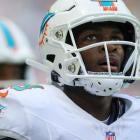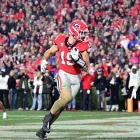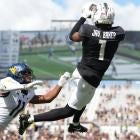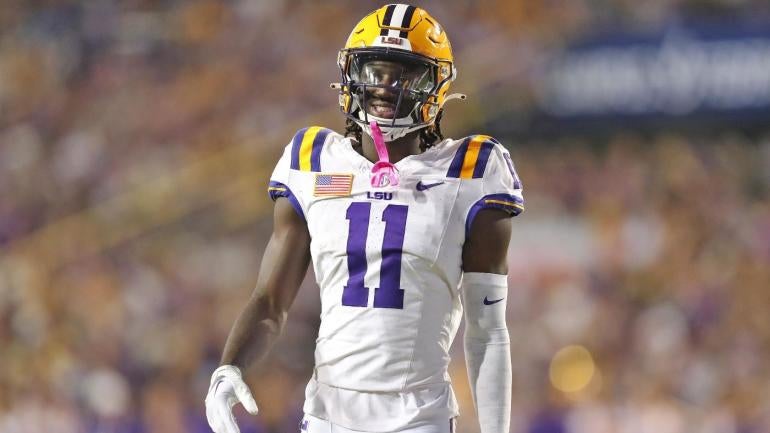
The Jacksonville Jaguars selected wide receiver Brian Thomas Jr. with the No. 23 overall pick in the 2024 NFL Draft after trading down from No. 17 with the Vikings. Here's what you need to know about his Fantasy stock in both season-long and Dynasty formats.
Thomas' Fantasy fit with the Jaguars
Candidly, this is a wonderful landing spot for Thomas, who brings a much-needed dimension to a Jacksonville offense that sorely needed speed after Calvin Ridley's departure. Though not polished as other receivers in the draft, Thomas' unique height and top-gear will give him the initial tools to make an impact against defenses that don't play two deep safeties against Jacksonville. For 2024, Thomas probably won't see quite enough targets to be a regular Fantasy staple, but is bench worthy and deserving of a pick after 90th overall.
Dynasty Outlook
As Thomas develops, the Jaguars could have a legit No. 1 receiver on their hands. It'll take a lot of refinement to his game without him adding much bulk (he's never been able to put on significant weight). Could that limit his upside? Sure, but we've seen smaller receivers with great speed make a massive difference on the field. Pairing him long-term with Trevor Lawrence keeps the door open for a good career as a big-play threat. Dynasty leaguers might see Thomas go off rookie-only draft boards as the fourth receiver taken, which would mean a top six or seven choice in one-QB formats and a top 10 or 12 selection in SuperFlex/two-QB.
Brian Thomas Jr.: What to know
Born on October 8, 2002, and raised entirely in Louisiana, Brian Thomas Jr.'s first love was football. He played youth ball and even in junior high, garnering attention because of his impressive height. But that same trait led him to the basketball courts, where he became a state sensation as soon as his freshman year at Walker High School, leading them to a come-from-behind victory in the state Class 5A Championship, being named the MVP of the title game. Thomas played basketball as a sophomore and a junior and even got some scholarship offers, but he "always loved football the most." His father wouldn't let him play football as a freshman (he was too "frail") but lifted weights and competed as a sophomore, where in his very first game he caught four passes for 218 yards and three touchdowns -- all on screen passes of 89, 63 and 75 yards. Then as a junior, Thomas grabbed 75 passes for 1,272 yards and 17 touchdowns. Thomas' size-speed combination brought better football scholarship offers than basketball did.
Despite two more deep playoff runs, Thomas was done with basketball by his senior year so he could focus solely on football. He downshifted statistically in 2020, catching just 30 passes for 507 yards with seven receiving touchdowns and two rushing scores over eight games. Regardless, he was invited to the Adidas All-American Bowl in 2021 and earned a four-star composite ranking from 247Sports. Thomas chose LSU, the school 30 minutes west on I-12 from his hometown, over top-notch programs like Alabama.
Age as of Week 1: 21 | Height: 6-foot-2 7/8 | Weight: 209 | Hand: 9 3/4 | Arm: 32 3/4 | Wing: 79 5/8 | 40: 4.34 seconds
Comparable body-type to: Tee Higgins
We're breaking down everything you need to know about Thomas from a Fantasy manager perspective, including a scouting report, key stats and an NFL comparison.
Scouting report
Strengths
- Excellent height (6-2 7/8) with long arms to match. Catch radius is one of the largest in the class.
- Lined up across the formation but was primarily an outside receiver.
- Primarily ran straight-line routes (go and hitch) but didn't fear in-breaking routes like shallow crossers, digs, overs and posts.
- Ran routes at varying tempos, in part to try and get the defensive back covering him flat-footed so he could race past him. Thomas also slowed up on shallow crossing routes when he didn't have a defender on his hip so he would be an open target longer.
- Very good long speed that's not common with receivers of Thomas' size. Has a top gear that should help him out-run a majority of defensive backs on downfield routes. Also was a long strider that helped him separate from coverage.
Brian Thomas Jr hauls in the 38-yard TD pass! 🎯 💯 🐯
— OutOfSightSports🚀™️ (@OOSSports) January 1, 2024
pic.twitter.com/BWOHdU1J2S
- Speed was his primary way of getting open but did utilize hesitations in his routes to often get defensive backs off-balance. Thomas' ability to stop and start his feet without losing too much time was solid.
- Footwork when turning back toward the quarterback seemed practiced and was effective (three steps). This provides hope that Thomas can expand his repertoire and be crafty with his feet to further add polish to his game.
- Basketball skills were on full display when Thomas leaped for jump balls against smaller defensive backs. Impressive hops were a huge factor when he competed for high throws and deep shots.
Jayden Daniels to Brian Thomas Jr. for the TD.
— The Cam & Tee Podcast (@TCTPodcast1) November 25, 2023
Thomas Jr has 15 TDs on the season.
📺: ESPN pic.twitter.com/XGLCeZI0SK
- Showed good understanding of where to sit down against zone coverage and await the target from the quarterback.
- Tracked the ball well on downfield bucket throws.
- Had a knack for walking the tightrope along the sideline. Would catch passes right against the line and maneuver his feet just right to add extra yardage. He'd also do a nice job of getting a foot in-bounds when leaping for a ball.
- Not afraid of after-catch contact and frequently found himself diving for maximum yardage once he encountered defenders.
- Very few reported injuries, the biggest of which being a concussion in October, 2022.
- Seems grounded. Listed basketball, video games, hanging with family and shopping as things he likes to do when he's not playing football.
Concerns
- Thomas' body is lean, an issue since high school (his father felt he was too "frail" to play football as a freshman). This led to a number of issues you'll read about below. It is a little alarming that he left LSU without developing more muscle. Teams might have to be okay with him never adding more weight.
- Route-running and route variety need some improvement. Rounded his cuts and would tip off his route to his coverage when he would lean into the direction of his break. The majority of his routes were either go-routes (straight line downfield) or hitch routes (run straight and turn back to the quarterback). He needs to add to his route tree, which isn't a big ask.
- Thomas' deep speed was unquestionably good, but he is not sudden in his lateral movements. His burst off the snap or after the catch and his acceleration in general left a lot to be desired. While he knowingly used tempo in his routes there's still scant evidence he was able to explode in short spaces and rarely if ever raced past defensive backs within the first five yards post-snap. I'm not sure this can be improved upon.
- Leaned heavily on a hesitation/fake-step combination off the snap to try and buy a step on defensive backs. The one move was effective at times but he didn't vary it too much or try many other tricks to get open post-snap. Thomas needs to add to his repertoire to make him less predictable, which isn't asking too much of him.
- Too many basket and body catches on film to say he had good hands. There were undoubtedly plays where he caught passes away from his body but there were just too many examples of Thomas cupping his hands to bring in targets. He needs to develop more consistent and refined hands. Practice makes perfect here.
- Would raise his hands early for the football and occasionally tip off defensive backs who were playing him and not the ball. This led to a lot of would-be receptions getting knocked away by savvy defensive backs. He can be better here pretty easily.
- Wasn't a consistently utilized threat in the red zone, and when he was, it wasn't near the goal line. That's not to say he couldn't win down there, just that he didn't have the chance to do it very often. More on that in the advanced stats below.
- Wasn't a physical player. Didn't get pressed much off the snap but did encounter physical defensive play and sometimes couldn't shed it. Regularly was stopped soon after first contact after the catch. Wasn't dominant on 50-50 balls even though he was super-sized compared to most of his competition. I'm not sure this can be improved upon.
- Effort as a blocker didn't seem to be a problem until his final game versus Wisconsin when he might have had a bout of "senioritis." However, his overall blocking was inconsistent and needs some coaching here in order to be at his best on running downs. He can get better here.
- Occasional moments where his body language suggested frustration, such as late in the game against Alabama last year. This isn't a hard fix.
Stats breakdown
| G | Tar | Rec | ReYds | Avg | Total TD | |
| 2023 | 13 | 87 | 68 | 1117 | 17.3 | 17 |
| 2023 v Top-25 | 4 | 28 | 22 | 368 | 16.7 | 5 |
| Career | 38 | 176 | 127 | 1897 | 14.9 | 24 |
Advanced stats to know
- Had a higher catch rate in 2023 (78.2%) than all three of the "big three" receivers (Marvin Harrison, Rome Odunze and his teammate at LSU, Malik Nabers). He did this with the second-highest Average Depth of Target (ADOT) among that same group (13.85; only Odunze's was higher).
- Had a higher drop rate (5.7%) and lower yards per catch (17.3) and yards per route run (2.73) averages than all three of the "big three" receivers. To be fair, he had fewer receiving yards and targets than they did.
- Not an advanced stat, but a cool one: Thomas led the FBS with 17 touchdowns in 2023 (age 21 season). Obviously that's more than any of the "big three."
- Of Thomas' 431 routes run last year, 127 were hitch routes (29.5%) and 88 were go routes (20.4%). That's effectively half of his total routes run. Not surprisingly, these were his two most targeted routes:
- On hitch routes, Thomas caught 30 of 36 targets for 321 yards and one touchdown with two drops.
- On go routes, Thomas caught 14 of 20 targets for 483 yards and a whopping 11 touchdowns with two drops.
- On all other routes, Thomas caught 24 of 31 targets for 373 yards and five touchdowns with one drop. Last year Thomas ran 15 out routes, 10 slants and eight corner routes with six total targets and a 4-58-1 stat line. This is a hint on where Thomas can improve his route tree versatility.
- Of his 1,177 receiving yards in 2023, just 162 came after first contact -- and 50 of those 162 came on a garbage-time play against Florida State.
- On throws of 5 or fewer Air Yards, Thomas caught 36 of 38 targets (94.7% catch rate) for 270 yards and two touchdowns. He averaged a meek 4.5 Yards After Catch (YAC) per reception on those short throws, playing into a terrible 5.3% explosive play rate. Overall, 43.7% of his targets, 52.9% of his receptions, 22.9% of his yards and 2 of his 17 touchdowns came on these short pass attempts.
- Here's a weird one: 10 of his receptions came on pass plays that traveled exactly three Air Yards. He averaged 8.9 yards per catch on these with one avoided tackle. Six of the grabs were on short hitch routes, three were on shallow crossing routes.
- On throws of 6 to 14 or fewer Air Yards, Thomas caught 9 of 16 targets (56.3% catch rate) for 106 yards and zero touchdowns. His YAC/reception on these intermediate throws was even worse than on short throws -- 2.8 yards. His explosive play rate was 12.5%. Each of the "big three" receivers were much better in this metric.
- Thomas' deep-throw metrics were impressive: On throws of 15-plus Air Yards, he caught 23 of 33 targets (69.7% catch rate) for 801 yards and 15 touchdowns. Because he sped past defenders on these throws, his 8.7 YAC/reception average and 60.6% explosive play rate were both phenomenal (but sort of obvious). While he scored more and had a better catch rate on these throws compared to his "big three" counterparts, Thomas still trailed Harrison and Nabers on yards per route run, suggesting those two were more efficient. It hurt Thomas that he had three drops on those deep targets, and it must be added that 10 of Thomas' 15 deep touchdowns came against opponents not ranked in the AP Top-25 poll (including two against Grambling State, two against Army, two against Arkansas and one against Georgia State).
- In the red zone, Thomas ran 47 routes and caught 8 of 11 targets with six touchdowns. Of the six scores, five came from the 7-yard line or farther. His catch rate was much better than any of the "big three," but his opportunities were much fewer (Nabers and Odunze had 19 targets each, Harrison had 23 in 12 games). Prior to 2023 he ran 58 red-zone routes, saw 13 targets, caught nine of them and scored three times.
- Inside the 10-yard line Thomas ran 18 routes and caught four of five targets, all for touchdowns. Again, his opportunities were slim compared to the "big three" receivers who had at least eight such targets each. One of his touchdowns was a pop pass caught behind the line of scrimmage that he ran in; the other three were either posts or slants where the defense made a mistake in coverage for him to take advantage of. None of these touchdowns came against ranked competition but one of them was the game-winner in LSU's bowl game against Wisconsin. Prior to 2023 he ran 23 routes inside the 10 and had three receptions, all for touchdowns (two in 2022, one in 2021).
- Inside the 5-yard line, Thomas had one target, one reception and one touchdown (versus Wisconsin) over seven routes run last year. In 2022, he had one target, one reception and one touchdown inside the 5 (versus UAB) on six routes run. In 2021 he ran three routes inside the 5 with no targets. You can do the math here to see how much he was utilized near the end zone.
NFL Comparison
As a prospect, Thomas has a lot in common with Denzel Mims and Josh Doctson when they came out -- they're all tall receivers with good speed but unfinished products. Mims and Doctson didn't pan out. But players with size and speed like Jordy Nelson, Javon Walker and D.J. Chark each came into the league with speed as their primary strength and managed to have solid-to-good careers; obviously Nelson fared much better than Walker and Chark. Thomas has a ways to go to match Nelson, but that upside is there. As for downside, it wouldn't be the worst thing in the world for him to have the career trajectory of Chark, another LSU receiver with height and speed but never added on to his game.














